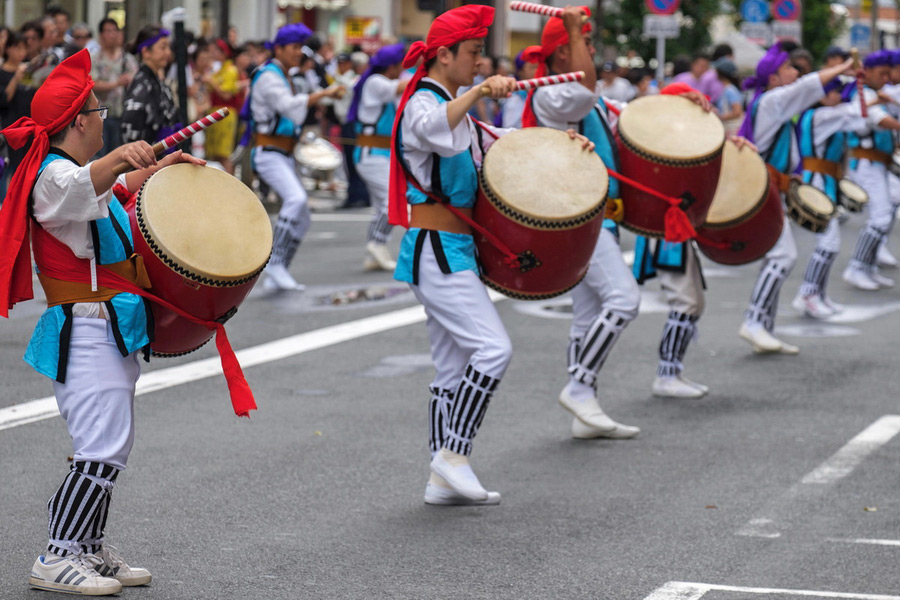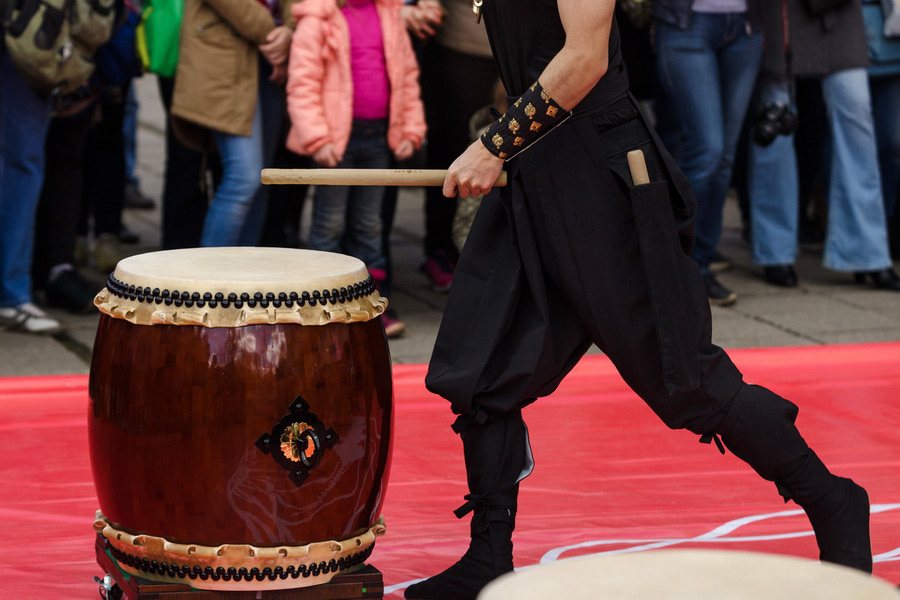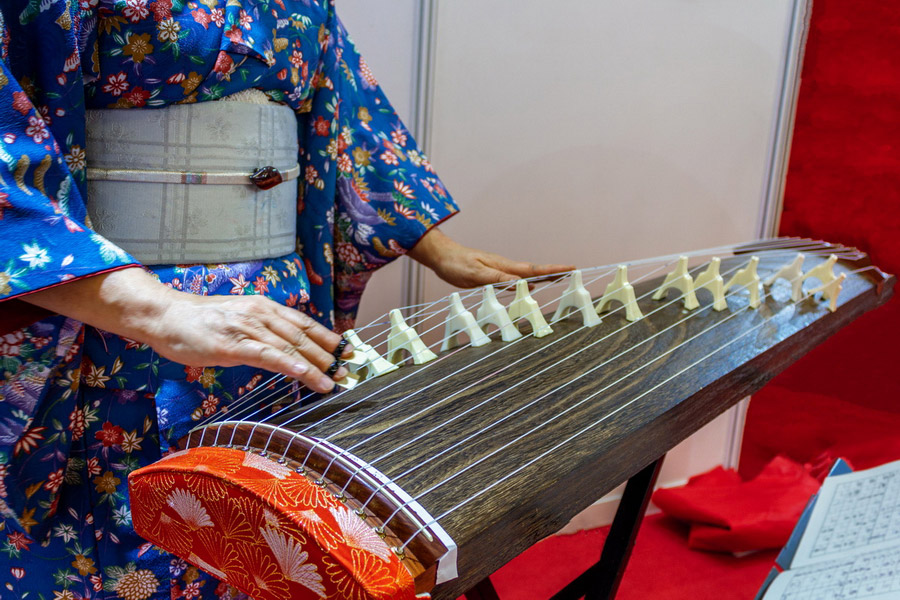
The Japanese music industry encompasses a variety of genres, from those unique to Japan to contemporary trends not found elsewhere. Remarkably, in 2022, Japan’s music market ranked second in size, right after the US.
Hogaku (Japanese music), gagaku (court music), and shomyo (Buddhist chanting) are terms to describe traditional music. In addition to traditional instruments, it emphasizes melodies that echo natural and environmental sounds, such as those of autumn insects, rivers, mountains, beaches, and even railway stations. Furthermore, unlike yogaku (Western music), which often follows strict rhythmic patterns, traditional Japanese music often mirrors the natural rhythm of human breathing.
In the 90s, Japanese music, with unique genres like J-pop, Idol, Enka, and Visual Kei, took the Western music scene by storm. These genres, along with music from anime and video games, made significant cultural impacts. Japanese cultural events and festivals often welcome a diverse lineup of Japanese singers, bands, and celebrities from all over the country, showing off their talents and the richness of Japanese music.
History of Japanese Music

Japanese traditional music can be traced back to ancient times. The country's native literary sources, the Kojiki (712 AD) and the Nihon Shoki (720 AD), provide insights into the role of music in early mythology. The tale about the goddess involves music and dancing to lure her out of hiding. These chronicles contain about two hundred mostly sung poems. However, if we turn to the Chinese documents from the third and sixth centuries, we’ll see that music was central to Japanese life from the early times. Archeological artifacts like bronze bells (dotaku), clay flutes, and drums indicate that music was known in the archipelago during that period.
More yet, the establishment of music as an institution happened during the first historical period of Japan, the Nara Period (710-794). During that time, the Japanese imported music from other countries. For example, the famous court music, known as gagaku in Japanese, came from China (it also incorporated elements from Korea and Southeast Asia). Aristocratic music is still called togaku (Chinese Tang Dynasty music). Similarly, with the spread of Buddhism from China, they also assimilated sacred music based on Buddhist rituals.
During the Heian (794-1185) and Kamakura (1185-1333) periods, several features of Japanese musical identity are visible. The native influence on the Buddhist hymns and secular songs produced during that era is undeniable. An example of that is imayo (modern) forms. However, the late Kamakura and Muromachi period (1333-1568) witnessed a decline in court music but a surge in theatrical forms, with drum-making reaching its peak. Drums from the Momoyama period (1573-1615) are highly esteemed in Japan, comparable to the Stradivarius violin.
The Tokugawa rule (1603-1868) was a tough time due to the military dictatorship and restrictions on religious practices, including Buddhist chanting. Despite these limitations, the Tokugawa period saw the advancement of traditional Japanese musical instruments. The shamisen, a three-stringed lute played with a large plectrum, and the koto, a long zither-like instrument with 13 strings, were highly favored. The shakuhachi, a bamboo flute used in Zen meditation, also gained prominence during this era. Additionally, noh and kabuki music gained popularity as theaters flourished during this period.

Following the Meiji Period (1868-1912), Western music, especially military music, penetrated the country. Western styles became prevalent, but traditional music eventually made a comeback. For example, hogaku artists entertained troops at military hospitals, and court music was opened to the public for the first time.
In summary, Japan's adoption of Chinese cultural elements, including music, during the Nara and Heian periods underwent a process of naturalization, transforming them into uniquely Japanese expressions. Interestingly, the best-surviving examples of Tang Chinese music are found today in the togaku music of the Japanese court orchestral music.
Gagaku Performances
Gagaku music was established at the Imperial Palace of Japan in 701, and the court music tradition remains alive. UNESCO recognized it as an intangible cultural heritage of humanity. Today, the Imperial Household Agency's Music Department preserves the gagaku tradition and organizes concerts both domestically and internationally.
Gagaku orchestras and ensembles usually perform at the Imperial Palace, State Dinner, and the Spring and Autumn events. In addition, there's the annual Gagaku performance at the National Theater of Japan. The prominent gagaku musicians are Shiba Sukeyasu and Naoyuki Manabe.
You can visit the Naoyuki Manabe Ensemble website and try booking a ticket for a concert in Tokyo.
Kagura Music

Kagura music, associated with the indigenous Shinto religion and folklore, is considered a form of Japanese folk music. This is a Shinto ritual dance that incorporates colorful costumes and expressive masks, drumming, and flute playing. Imperial kagura is mainly performed at important shrines before Shinto deities and the Imperial Court, while folk kagura is a ceremony to ask for abundant harvest and good luck.
If you want to hear Kagura music, head to the western region of Shimane Prefecture, Iwami no Kuni, and Hiroshima Prefecture. The areas boast this living tradition by holding regular kagura performances.
Shomyo
Shomyo, meaning 'clear voice,' is a form of Buddhist ritual chanting. Until 1966, this form of music, traditionally performed by monks in temples and at the imperial court, was not widely known among the Japanese public. However, the grand Shingon priest, Yuko Aoki, revolutionized shomyo, making it available to the masses.
On Apple Music, you can listen to a well-known monk's choir, Shomyo no Kai-Voices of a Thousand Years. Likewise, the Buddhist chanting occurs at the temples of Todai-ji, Hieizan Enryaku-ji, and the National Theater of Japan.
Noh and Kabuki Music
Noh and Kabuki are integral to Japanese music and Japanese culture, with music playing a pivotal role in both theater genres.
Noh performances are accompanied by an instrumental ensemble called Hayashi-kata, and Kabuki also prominently features the shamisen.
Visit Noh performances to experience this unique blend of music and theater. The National Noh Theater and the Kanze Noh Theater in Tokyo are renowned venues. Osaka offers the Otsuki Theater, and Nagoya has the Nagoya Noh Theater near Nagoya Castle.
Japanese Traditional Music Performers
There are around 33 types of musical instruments used in Japan. Many of these have a deep history. Among the many traditional instruments of Japan, the most popular are biwa, shamisen, shakuhachi, and koto.
If you're interested in exploring traditional Japanese music further, we suggest checking out these contemporary artists. They incorporate traditional elements into their work, giving it a unique twist.
For example, the renowned Yoshida Brothers specialize in the Tsugaru-shamisen style that originated in northern Japan. Since their debut in 1999, they have released several successful albums that have won the hearts of Japanese and international audiences. Another artist worth checking out is Yutaka Oyama, a third-generation shamisen player.
A fascinating figure in the world of Japanese traditional music is Riley Lee. He has been playing shakuhachi since 1971. Notably, Lee earned the distinction of being the first non-Japanese musician to achieve the prestigious rank of Dai Shikan in shakuhachi performance. The New York Times has described his music as 'spellbinding,' capturing 'the echoes of eternal life’.
Nozomi Miyanishi shines as a unique artist who has successfully blended Western and traditional Japanese koto music. A notable figure was Tadao Sawai, a koto performer and composer who left behind an impressive legacy of over 100 musical recordings.
Finally, we can’t help but mention young generation bands like Wagaki and Sakiyama Tsubasa and the Sakura Men that are also making waves in the Japanese music scene. Their music is a fusion of traditional instruments such as the shamisen, taiko, and shakuhachi. The female trio Rin has garnered attention for its unique combination of pop and rock music performed with traditional instruments.
Japanese Classical Music
Tokyo is one of the world’s great centers for classical music. Its eight symphony orchestras regularly give concerts in major North American and European cities. Today, Japanese artists like Midori Goto (a violinist and Seiji Ozawa (a conductor) are big names in the United States; the Suzuki Method is known worldwide; and the highly praised Tokyo String Quartet is a highlight at various concerts across America and Europe.
Modern Japanese Pop Culture
Modern Japanese pop music emerged in the 1990s under the influence of rock groups like The Beatles, The Rolling Stones, and others. It replaced kayokyoku, a style of lyric singing music popular from 1920 to 1980.
Unlike previous stages of Japanese popular music, the title J-pop took the Western style. In the same manner, contemporary music adopted elements foreign to Japanese traditional music but continued to utilize traditional singing and melodies. Over time, GS (Group Sound) bands appeared on the scene, becoming a transitional link between the old and new styles of Japanese Western-influenced music.
The abbreviated expression J-pop first appeared on the radio station J-Wave. Later, it became a general title, bringing prominent rock bands of the 1990s under its umbrella. In 1990, Tower Records Japan labeled J-pop as a term uniting the entire Japanese music that belonged to the recording industry of Japan, except for the independent J-indie genre.
The B Zone artists and bands dominated the charts in Japan. For example, the B’z was the top rock band among them. In the early 1990s, Namie Amuro emerged as a prominent J-pop star, particularly from 1995 to 1997. She laid the foundation for fashion trends of future gyaru (“gal” from English). Many girls copied her style, wearing miniskirts, long boots, tattoos, and spending hours in solariums to get tanned skin. In 2009, the Tsutaya Online magazine dubbed her the “#1 fashion icon of Japan." Girls who mimicked her were called Amuraa. That’s when the word gal began to disseminate and become trendy.
Early in the 2000s, the record company Avex Trax brought on board strong artists like Ayumi Hamasaki, Gackt, Girl Next Door, AAA, Do As Infinity, and others. Avex is the biggest record label in Japan, occupying between 15% and 20% of the entire Japanese industry.
Karaoke
The term 'karaoke' comes from a Japanese phrase, with 'kara' (カラ) meaning 'empty' and 'okesutora' (オーケストラ) meaning 'orchestra. It’s a form of entertainment that allows people to sing using a device with pre-recorded accompaniment and a microphone.
The first karaoke machine was invented by a Japanese engineer, Shigeichi Negishi. Later, in 1971, a Japanese musician, Daisuke Inoue, made his own device in Kobe.
Once an expensive form of entertainment, karaoke has gained global popularity. Japan has many specialized karaoke bars and clubs, and Japanese artists frequently release new singles for anyone to perform in karaoke.

